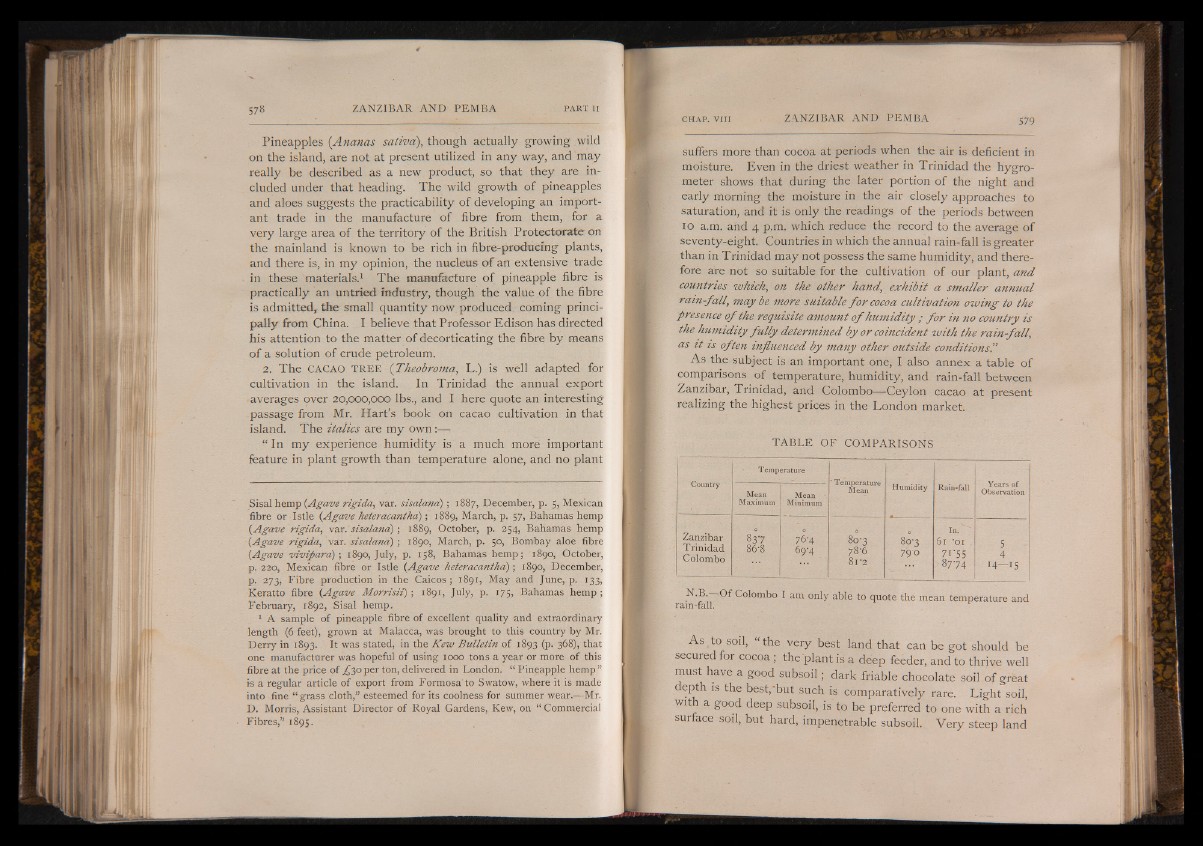
Pineapples (Ananas saliva), though actually growing wild
on the island, are not at present utilized in any way, and may
really be described as a new product, so that they are included
under that heading. The wild growth of pineapples
and aloes suggests the practicability of developing an important
trade in the manufacture of fibre from them, for a
very large area of the territory of the British Protectorate on
the mainland is known to be rich in fibre-producing plants,
and there is, in my opinion, the nucleus of an extensive trade
in these materials.1 The manufacture of pineapple fibre is
practically an untried industry, though the value of the fibre
is admitted, the small quantity now produced coming principally
from China. I believe that Professor Edison has directed
his attention to the matter of decorticating the fibre by means
of a solution of crude petroleum.
2. The CACAO TREE (Theobroma, L.) is well adapted for
cultivation in the island. In Trinidad the annual export
averages over 20,000,000 lbs., and I here quote an interesting
passage from Mr. Hart’s book on cacao cultivation in that
island. The italics are my own:—
“ In my experience humidity is a much more important
feature in plant growth than temperature alone, and no plant
Sisal hemp (Agave rigida, var. sisalana); 1887, December, p. 5, Mexican
fibre or Istle (Agave heteracantha) ; 1889, March, p. 57, Bahamas hemp
(Agave rigida, var. sisalana) ; 1889, October, p. 254, Bahamas hemp
(Agave rigida, var. sisalana) ; 1890, March, p. 50, Bombay aloe fibre
(Agave vivipara) ; 1890, July, p. 158, Bahamas hemp; 1890, October,
p. 220, Mexican fibre or Istle (Agave heteracantha)-, 1890, December,
p. 273, Fibre production in the Caicos ; 1891, May and June, p. 133,
Keratto fibre (Agave M o rrisii); 1891, July, p. 175, Bahamas hemp ;
February, 1892, Sisal hemp.
1 A sample of pineapple fibre of excellent quality and extraordinary
length (6 feet), grown at Malacca, was brought to this country by Mr.
Derry in 1893. It was stated, in the Kew Bulletin of 1893 (p. 368), that
one manufacturer was hopeful of using 1000 tons a year or more of this
fibre at the price of ,£30 per ton, delivered in London. “ Pineapple hemp ”
is a regular article of export from Formosa to Swatow, where it is made
into fine “ grass cloth,” esteemed for its coolness for summer wear.— Mr.
D. Morris, Assistant Director of Royal Gardens, Kew, on “ Commercial
Fibres,” 1895.
suffers more than cocoa at periods when the air is deficient in
moisture. Even in the driest weather in Trinidad the hygrometer
shows that during the later portion of the night and
early morning the moisture in the air closely approaches to
saturation, and it is only the readings of the periods between
10 a.m. and 4 p.m. which reduce the record to the average of
seventy-eight. Countries in which the annual rain-fall is greater
than in Trinidad may not possess the same humidity, and therefore
are not so suitable for the cultivation of our plant, and
countries which, on the other hand, exhibit a smaller annual
ram-fall, maybe more suitable fo r cocoa cultivation owing to the
presence o f the requisite amount o f humidity ; fo r in no country is
the humidity fu lly determined by or coincident with the rain-fall,
as it is often influenced by many other outside conditions'.’
As the subject is an important one, I also annex a table of
comparisons of temperature, humidity, and rain-fall between
Zanzibar, Trinidad, and Colombo— Ceylon cacao at present
realizing the highest prices in the London market.
TAB LE OF COMPARISONS
Country
Temperature
' Temperature
Mean Humidity Rain-fall Years of
Mean Observation
Maximum
Mean •
Minimum
Zanzibar
Trinidad
Colombo
0
837
86-8
à
76-4
69-4
80-3
78-6
8i ’2
8o'3
790
In .V
61 -OI _
7 i '55
58774
4
14— 15
N.B. Of Colombo I am only able to quote the mean temperature and
ram-fall.
As to soil, “ the very best land that can be got should be
secured for cocoa ; the plant is a deep feeder, and to thrive well
must have a good subsoil; dark friable chocolate soil of great
epth is the best/but such is comparatively rare. Light soil,
with a good deep subsoil, is to be preferred to one with a rich
surface soil, but hard, impenetrable subsoil. Very steep land